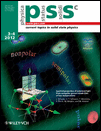Recent progress of efficient deep UV-LEDs by plasma-assisted molecular beam epitaxy
Abstract
We report the development of efficient AlGaN-based deep ultraviolet (UV) LEDs emitting in the wavelength range from 320 nm to 265 nm by plasma-assisted molecular beam epitaxy (MBE). By growing the AlGaN well layers under Ga-rich conditions to produce strong band structure potential fluctuations, the internal quantum efficiency (IQE) of the quantum wells, which are used as the active region of the UV LEDs, was found to be as high as 32%. Unpackaged deep UV-LEDs emitting at 273 nm were found to have an optical output power of 0.35 mW and 1.3 mW under DC and AC injection current of 20 mA and 100 mA respectively. The maximum external quantum efficiency under DC injection was measured to be 0.4%. (© 2012 WILEY-VCH Verlag GmbH & Co. KGaA, Weinheim)




